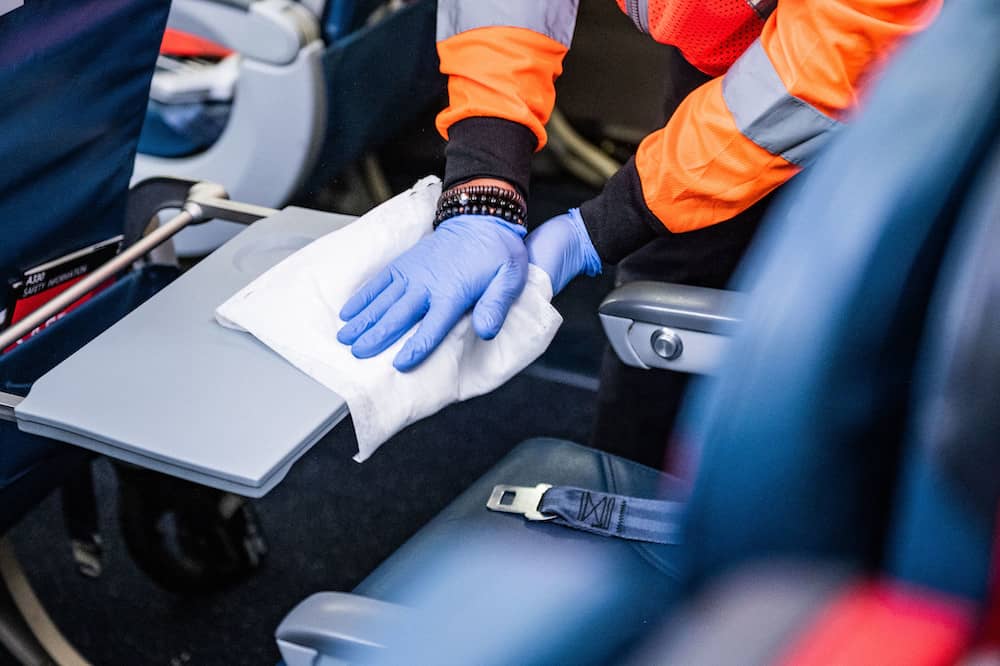
[Image above] Airplanes implemented much more rigorous cleaning and disinfecting measures following the start of the COVID-19 pandemic. Credit: Delta News Hub, Flickr (CC BY 2.0)
When the COVID-19 pandemic first began, much attention was given to disinfecting surfaces to prevent spread of the SARS-CoV-2 coronavirus. Though we now know that surfaces are a rare source of infection for this virus, surfaces do play a notable role in the transmission of some other contagious viruses, such as norovirus and HIV. So the increased focus on developing new viral disinfectants is useful even beyond COVID-19.
Disinfectants based on inorganic materials have gained much attention recently due to setbacks with organic-based disinfectants, which have low resistance to heat, high decomposability, and short lifespans.
Metal-based nanoparticles are one type of inorganic material that has received attention. These nanoparticles have antimicrobial properties, in addition to physicochemical properties related to high specific surface area and small size that allow interaction with small infectious agents like viruses.
However, as in other areas investigating the use of nanoparticles, there are concerns related to the possible environmental, health, and safety risks of nanoparticles. Stabilizing the nanoparticles in a clay matrix is one way to mitigate these concerns.
Clay minerals are commonly used in the pharmaceutical industry as ingredients or additives due to their thermal and chemical stability, biocompatibility, low toxicity, and relative abundance. Researchers have extensively investigated their use as advanced drug delivery systems as well, including to deliver various metallic nanoparticles.
Glasses and glass-ceramics are two other inorganic materials that are being explored for use as a disinfectant. Currently most medical research on these materials has involved bone repair and tissue engineering applications, but there is an increasing interest in their potential antimicrobial properties. Studies have shown their effectiveness against some common clinically relevant pathogens, including E. coli, P. aeruginosa, M. luteus, and S. aureus. However, their effectiveness against viruses has not been assessed so far.
In a recent open-access paper, researchers from several universities and institutions in Spain investigated the potential of both types of above-mentioned inorganic materials as viral disinfectants.
In an email, ACerS Fellow and CINN-University of Oviedo professor José S. Moya explains that he and other researchers associated with the Nanomaterials & Nanotechnology Research Center (CINN), which is a joint initiative of three institutions, have spent the last 10 years studying inorganic materials with strong bactericidal activity. When the COVID-19 pandemic began, the National Spanish Council for Scientific Research requested that they investigate if these inorganic materials also had virucidal activity.
Moya says they chose to investigate both nanoparticle-embedded clay and glass in this study so they could compare results from a material with known virucidal activity (a nanoparticle-embedded clay) and a material with unknown virucidal activity (a glass).
For the nanoparticle-embedded clay, the researchers chose kaolin embedded with silver or copper oxide nanoparticles because it has been previously described in the literature as a material with virucidal activity. For the glass, they chose a biocompatible and antibacterial soda-lime glass with high CaO content that to date has unknown virucidal activity. They tested the effectiveness of the two materials against both enveloped and nonenveloped viruses. (See sidebar: Virus structure.)
The researchers found that both the nanoparticle-embedded kaolin and soda-lime glass demonstrated strong antiviral properties against both enveloped and nonenveloped viruses. Specifically, the materials led to a more than 99.9% reduction of viral infectivity after one hour in contact with the viruses.
The researchers suggest that the mechanisms behind the reduced viral infectivity are related to the properties of the materials. In the case of the nanoparticle-embedded clay, kaolin adsorbs the virus on its surface and dispenses the nanoparticles only as need to inactivate viruses rather than releasing the nanoparticles into the environment.
Virus structure: Enveloped versus nonenveloped
Developing viral disinfectants can be challenging depending on the virus structure. All viruses feature a protein shell called a “capsid” that encloses their genetic material. However, some viruses feature an additional membrane layer composed of lipids and proteins around the capsid.
These “enveloped” viruses, including SARS-CoV-2, require both an intact capsid and membrane layer to infect cells. Common disinfectants and even soaps can be effective at disrupting the membrane, thus destroying the viruses’ ability to infect host cells.
In contrast, nonenveloped viruses, or ones without the extra membrane layer, must have their capsid disrupted to stop their infection ability. This disruption requires much stronger disinfecting substances than those required for enveloped viruses.
In the case of the soda-lime glass, the glass appears to induce virus aggregation. However, some details of the glass virucide mechanism remain unknown. For example, Moya says they do not yet know if the release of ions in the glass causes membrane depolarization, such as that observed in the case of bacteria, or if a synergistic effect is produced by release of calcium and boron ions.
“At the present moment we are in contact with the group of virologists led by Prof. E. Nistal to carry out a more complete study that allows us to know in more detail the mechanism of action of the G3 glass and the possible synergistic effect of calcium and boron,” Moya says.
The open-access paper, published in Materials Today Bio, is “Broad virus inactivation using inorganic micro/nano-particulate materials” (DOI: 10.1016/j.mtbio.2021.100191).
